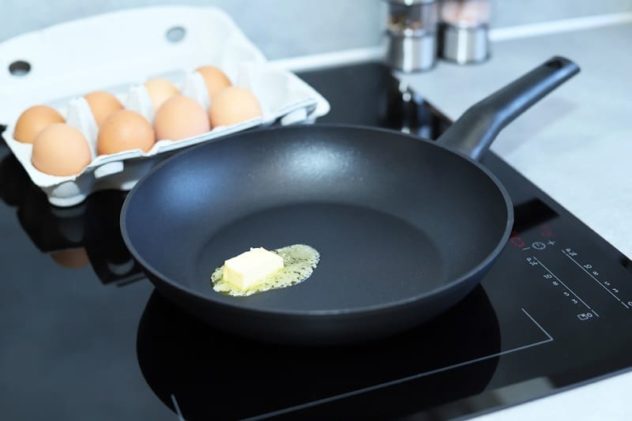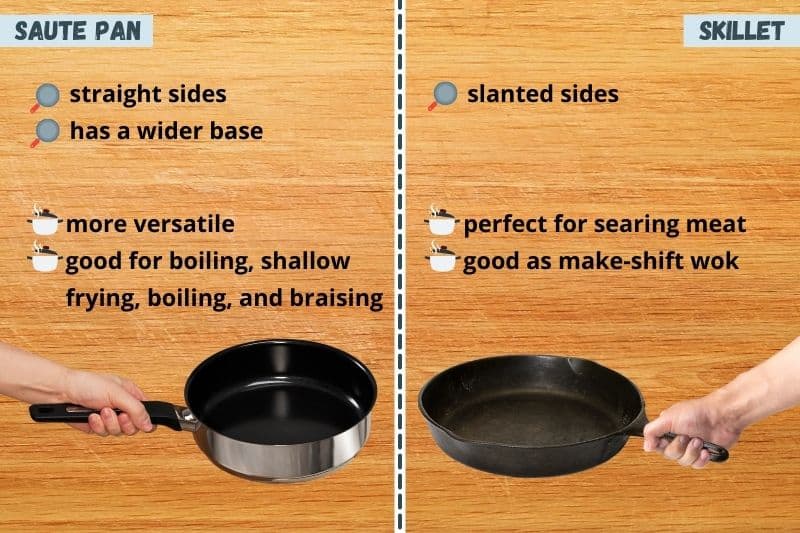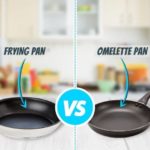Ah, another age-old cooking question that has fuelled debates between cooks for years—is there a difference between frying pans and sauté pans?
After all, most of us home chefs (and I certainly include myself in this group), use frying pans and sauté pans interchangeably. Still, is this really a cooking faux pas? Will Gordon Ramsey strike us down because we are incorrectly using one of these pans when in fact, we should just wash up the frying pan and use that instead? Well, let’s find out, shall we?
What Is the Difference Between Frying Pans and Sauté Pans?
If you have a sauté pan and a frying pan, like myself, and you’ve ever put them side by side to try and determine the differences between these pieces of cookware, you may be a bit lost.
Despite the lid of the sauté pan, they look practically the same. So, is the lid the difference?
Difference 1: Sauté pan has a lid
The lid on a sauté pan certainly makes it more versatile than a frying pan. As you can use the lid to lock in heat and moisture, meaning that you can do several cooking tasks with a sauté pan that you can’t do with a frying pan.
Difference 2: Sauté pan has more vertical walls
Another difference between these pans is the walls. Take a close look at your sauté pan and frying pan, and you’ll see that the walls of a sauté pan are at a steeper angle. The walls of a frying pan are a bit more angled, making them perfect for flicking your food as you frying it and looking all cool.
Of course, the steeper sides of sauté pan mean that you can cook saucier dishes in them. You can make a curry in a sauté pan very simply, while you would struggle to do so in a frying pan.
You can also use a sauté pan for searing meat. So, you can achieve a fantastic chilli, curry or casserole using one pan, handy, easy and saves on washing up too!
Also, depending on the style of sauté pan you have, you can often put these pans in the oven too. The one I own has plastic handles and a non-stick coating so I can’t, but if yours is stainless steel, you can pop your sauté pan into the oven to finish off a variety of meals.

Can You Use Frying Pans and Sauté Pans Interchangeably?
I can safely say that most chefs would kick you out of their kitchen if you were to grab a frying pan for a sauté pan’s job. However, if they aren’t standing in your kitchen, they will never know!
While sauté pans are better for a few jobs that a frying pan isn’t ideal for, they do still work great as the humble frying pan too. We are not here to judge your sauté pan usage.
I certainly use my sauté pan for all of the glorious reasons that we bought it for. To create saucy dishes in one pot that can sear the meat and trap in that flavour too.
Still, I am never shy about reaching for the sauté pan when the frying pan needs washing up or just because I fancy using it.
So, perhaps using a sauté pan for a frying pan’s job is a little bit of a faux pas in a professional kitchen, but don’t worry, we won’t tell anyone!
Sauté Pan vs. Frying Pan – Which Should I Buy?
Until about a year ago, I had exclusively used frying pans for most of my cooking life. I have flirted with a skillet or two in my time, but I hadn’t had the chance to give a sauté pan a try. If you’re looking for a pan that will provide one solution to your hob problems, get the sauté pan as you can do loads with them.
However, I have both a frying pan and a sauté pan and love using them both. A sauté pan is a fantastic tool, but so is a frying pan. You are limited to what you can do with a frying pan, though. Still, I would argue that if you’ve got the money and the passion for cooking, grab both!
We hope this look at the differences between frying pans and sauté pans has been helpful. To find the perfect frying pan or sauté pan for you, please explore our website further. See our reviews of the best sauté pans here. We have loads of amazing cookware on here that will be an excellent addition to your kitchen!
What’s the Difference Between a Sauté Pan and a Skillet?
Should you buy a skillet or a saute pan? That is an age-old cooking question that has plagued all home cooks for years.
The trouble is, these pans look so similar that many of us don’t even know the difference between a saute pan and a skillet.
Is there actually a difference? Will you notice the difference while cooking? Should you buy both pans, or will one of these amazing pans do the job of both?
First, let’s look at the differences are between saute pans and skillets, shall we?
The differences between sauté pans and skillets
A sauté pan has straight sides or sides that have a very slight curve to them. Skillets, on the other hand, have slanted sides.
Thanks to the straighter sides, a sauté pan has a larger cooking surface. So, when you buy a 12-inch sauté pan, the cooking surface is actually 12-inches. When you buy a 12-inch skillet, on the other hand, the cooking surface is usually closer to 10-inches.
This isn’t cooking manufacturers misleading us, by the way. The measurements are always taken at the rim of the pan.

Sauté pans also come with a lid, unlike skillets. The lid means that a sauté pan can be used for a lot more cooking tasks.
While sauté pans and skillets are both amazing for searing meats and frying steaks, for example, sauté pans can also be used for reducing sauces and even boiling veg and things like that.
Skillets are great for a lot of tasks, too, though. Thanks to the slanted sides, they can be used in place of a wok for stir-frying. They are perfect for any cooking tasks that involve moving the food around a lot during the cooking process, for example.
As you can see, the differences between these pans are pretty small, and both can be used for very similar cooking tasks, so which one should you choose?
When to use a skillet rather than a sauté pan
One of the biggest reasons that skillets and saute pans get confused so much is because they can almost be used interchangeably.
We have both a skillet and a saute pan in our home, and we honestly grab whichever one is closer to us when we are cooking steaks, fish or quick-frying veg.
We love both and wouldn’t be without both in our kitchen. If I had to choose between a skillet or a saute pan, I would choose a saute pan, and here’s why.

Sauté pans are much more universal than a skillet. While skillets are perfect for searing meats and using as a make-shift wok, sauté pans can do all of this and more.
Sauté pans can be used for stir-fries, shallow-frying, poaching, boiling, braising, and so much more. They also have a huge cooking surface.
Most of the time, we cook for two people, but when we have friends over, we know that our 12-inch saute pan can cope with the additional mouths to feed.
In my opinion, skillets and sauté pans both have a place in our kitchens, and we certainly wouldn’t be without both in our kitchen. We use both almost every day, and we use them both for very similar cooking tasks. Having both a skillet and sauté pan in your kitchen is really handy.
However, if you can only have one, a sauté pan is more versatile as you can use it as a saucepan in a pinch, thanks to the straighter sides and the lid. So, if you can only have one, a sauté pan would be our choice.
We have all of the best sauté pans and skillets available in the UK right now here on Chef’s Pick.
So, make sure to check out our recommended skillets and saute pans before you leave. We also have other articles about saute pans if you want to see what these pans are capable of!

Scott is a writer and a passionate home chef. His passion for cooking began when he was 10 years old. Scott has been writing professionally for over five years now and loves to combine his passion for cooking with his day job.







